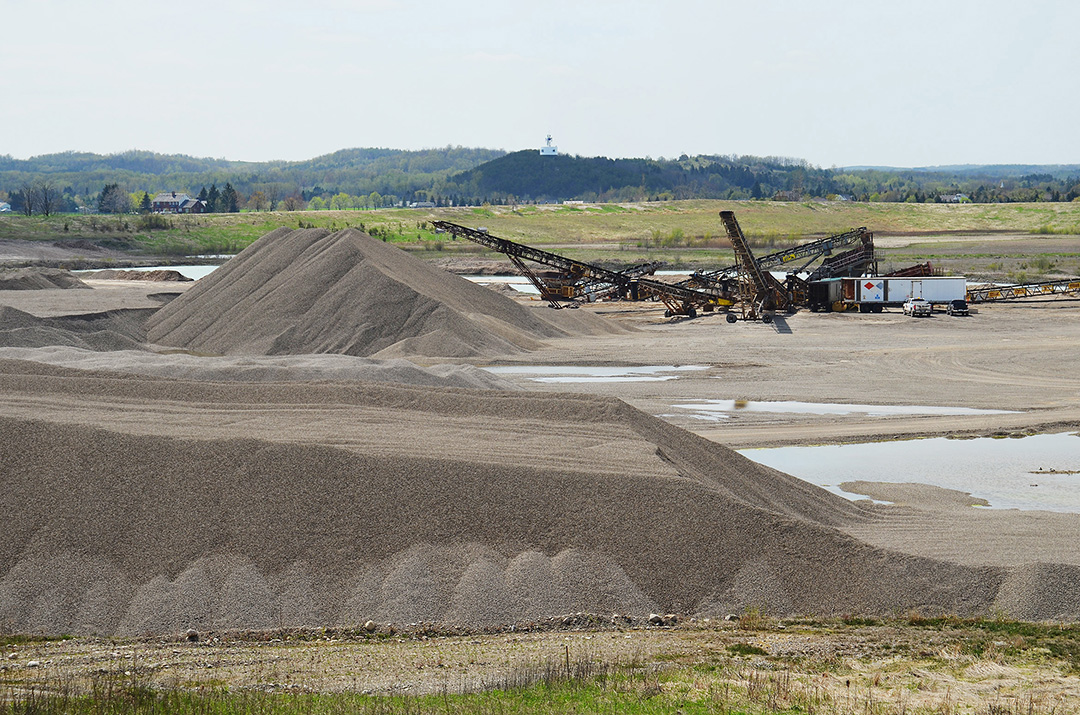TORONTO – The Ontario government’s intention to promote economic growth in the aggregate industry is raising eyebrows among people dedicated to restraining the establishment of new pits in Wellington County.
John Yakabuski, minister of natural resources and forestry (MNRF), announced on Feb. 20 that Ontario will host a summit on aggregate reform on March 29.
“Our government is committed to creating the conditions that will help unleash the resource sector’s potential,” said Yakabuski.
“We want to work with industry leaders on how we can tear down barriers to create an environment for growth and a sustainable resource sector.”
The government says the aggregate industry contributes almost $1.4 billion to Ontario’s economy and supports almost 20,000 direct and indirect jobs.
But proposals for new gravel pits and rock quarries frequently result in passionate opposition from groups of local residents.
“‘Red tape’ can be code for too much worry about the environment,” said Linda Sword of the Concerned Residents Coalition (CRC).
The group was formed in March 2013 to scrutinize a quarry application by aggregate developer James Dick Construction Limited in Guelph-Eramosa Township.
She said changes may be needed to the pit approval process, but “not at the cost of the environment”.
The CRC is hoping the upcoming consultation with the aggregate industry will be matched by consultation with the public. The group has invited the minister to a meeting about the local situation.
The government appears to be responding to a submission they received from the Ontario Stone, Sand and Gravel Association (OSSGA) called “Untangling Red Tape.”
It states duplication and inefficiencies in the regulation of aggregate businesses have been a barrier to investment and have contributed to applications taking up to 12 years to be approved.
“We are confident that significant reductions in red tape can occur without compromising the strong environmental protection inherent in Ontario legislation and policy,” the report says.
Roy Val, an Erin resident who has worked to mitigate the impact of the expansion of the Halton Crushed Stone pit south of Erin village, said the MNRF should be focusing on enforcing existing on-site regulations at pits.
“Tearing down barriers will create aggregate anarchy and increase competition (lower prices for the largest consumer – the provincial government), all likely at the expense of our environment,” said Val.
“Aggregate pits in and around Erin are required to protect the activities of the barn swallow, bobolink and eastern meadowlark, as per the Endangered Species Act (ESA). Will this government roll back these protective measures as well?”
Val said he is concerned about the suspension of the Cornerstone Standards Council, which set standards for best practices in the industry.
Most aggregate companies were not willing to undergo the council’s certification process.
In its recent submission the industry calls for consistency and a single point of responsibility at the provincial level, instead of multiple ministries and regional offices. It also requests elimination of “multi-agency review”.
The industry says 48 per cent of available aggregate has been made unavailable “due to changes to the rules on endangered and threatened species and other policies within the Natural Heritage System that violate/contradict provisions in the Endangered Species Act (ESA).”
The OSSGA also states that introduction of the Local Planning Appeal Tribunal (LPAT), to replace the Ontario Municipal Board (OMB), appears to require a whole new set of hearings in aggregate cases.
This could increase the time and cost to move an aggregate licence or zoning permit through the system.
The industry says 250 tonnes (12 truck loads) of aggregate are required to build a house, 13,000 tonnes for a school, 51,800 for one kilometre of a six-lane highway and 91,200 for 1km of subway track.
An MNRF report in 2010 stated Ontario had used up over three billion tonnes of aggregate over 20 years, an average of 164 million tonnes per year.
And while it was being used faster than reserves were being licenced, existing in-ground reserves were significant.
Total reserves were estimated at 3.44 billion tonnes, of which only 902 million tonnes were conveniently located within the GTA (within 75km of Vaughan). Reserves of high quality stone were estimated at 1.47 billion tonnes, with 987 million tonnes of sufficient quality for concrete and asphalt and 317 million tonnes that were within 75 km of Vaughan.
The Untangling Red Tape report states that if every aggregate truck travelled just one extra km to its job site, 2.5 million litres of additional fossil fuel would be burned every year.
Aggregate firms do not need to prove a need for their product when applying for a new pit, and a desire to locate close to their market is considered a valid factor.
The OSSGA report says, “Consider that by 2041 there will be 18.2 million people in Ontario.
“To support this growth, 3.84 billion tonnes of aggregate will be needed to build the roads, schools, hospitals, homes and other public buildings we all use (that’s more than 100 million truckloads of aggregate).”




